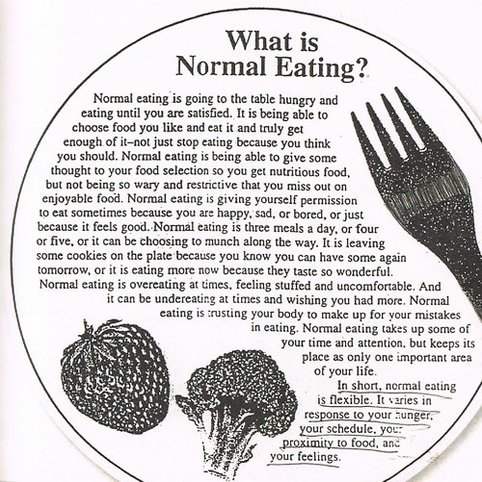This topic is near and dear to my heart. I find myself revisiting the definition of normal eating throughout my work with clients. We review what normal eating looks like and how to develop normalized eating patterns. The tricky part is defining what normal eating is for each individual client and guiding them on their journey to achieving it. This work serves as a constant source of inspiration as well as frustration for those that remain constricted and uncomfortable around food.
Unfortunately, our diet and food obsessed society bombards us with pressures to veer off track from intuitive eating which creates nearly impossible challenges for some. With patience and hard work, I have worked with clients to embrace a new way of eating. Truly, the most rewarding part of my work, is witnessing the overwhelming freedom that clients feel from intuitive eating. At first clients may be fearful of their own internal cues and experimenting with flexibility around food. But with more practice, the taste of freedom is enough motivation to continue to develop normal eating. The rules and restrictions they previously created for themselves gave all of the power and control to food. My clients are motivated and ready to take back that power and control over food by listening to their own body and internal regulations that, refined by evolution, have worked for thousands of years.
 I love this definition of normal eating by Ellyn Satter. Check out her website and the literature that she has published on The Division of Responsibility. More to come on this in future posts.
I love this definition of normal eating by Ellyn Satter. Check out her website and the literature that she has published on The Division of Responsibility. More to come on this in future posts.
Our food system, cultural influences and societal beliefs play a role in the food that we eat. These have all changed drastically over the last century. Although our body was built to regulate our eating, admittedly our food looks very different these days. Processed, packaged and additive laden foods inundate our grocery stores. It tempts our tastebuds and manipulates our mind. Whole foods always will remain the basis of a balanced and nourished body. However, my definition of normal eating must include some processed, packaged foods in order to simply enjoy life.
I don’t worry about going out to a restaurant to eat with my family and friends. There is no need to be concerned about the food coloring or additives in the Easter cupcakes that my kids will eat this weekend at school. I am confident in the food that I feed my family. Whole grains, pasture raised meats, fermented foods, whole milk dairy, fruits and vegetables all contribute to their daily meals and snacks. They are growing and thriving and their nutritional needs are met. This flexibility is essential for not only their health and well being, but also mine. It is how we teach young, impressionable eaters to follow their internal signals in our food culture. We model balanced eating and flexibility of food as a family unit and enjoy eating all different foods together.
 My husband and I do our best to model a balanced relationship with food for our kids. We eat dinner together at our kitchen table and our four year old daughter loves to be around food. She helps me in the kitchen cut up vegetables (her favorites right now are garlic and carrots, she doesn’t like onions because they make her eyes burn). At the grocery store she picks out our favorite brands and staples (in addition to marshmallows and hot chocolate). She also helps me meal plan and chooses the family dinner at least once a week so she has some choice in the foods that we eat.
My husband and I do our best to model a balanced relationship with food for our kids. We eat dinner together at our kitchen table and our four year old daughter loves to be around food. She helps me in the kitchen cut up vegetables (her favorites right now are garlic and carrots, she doesn’t like onions because they make her eyes burn). At the grocery store she picks out our favorite brands and staples (in addition to marshmallows and hot chocolate). She also helps me meal plan and chooses the family dinner at least once a week so she has some choice in the foods that we eat.
One of her go-to meal requests right now is macaroni and cheese. Her favorite is her grandmother’s home made version, but it is nice to be able to put a complete meal on the table in less than fifteen minutes on those crazy mom days. The other night we had steamed fresh green beans, whole grain macaroni and cheese (yes it is from a box!), and free range hot dogs. Not pictured were some dried cherries on the side. My daughter was quieter than usual (because she was busy eating!) which created a welcome chance for all of us to share about the events from our day!
Until next time, eat well!
Questions for comments: What are some of your favorite family meals? How do you get your kids involved in family meals? What does normal eating look like to you? How do you struggle with balanced eating and what are some things you’re working on?


Recent Comments